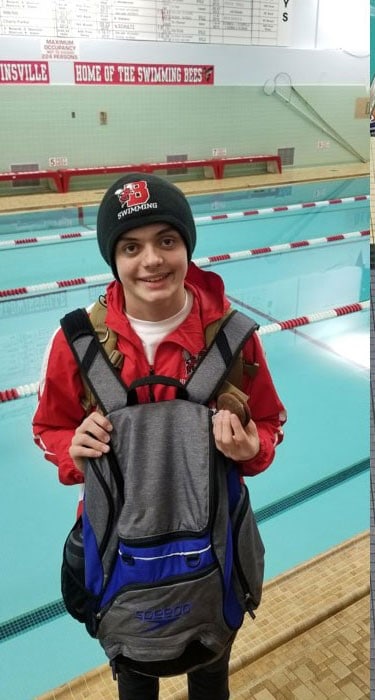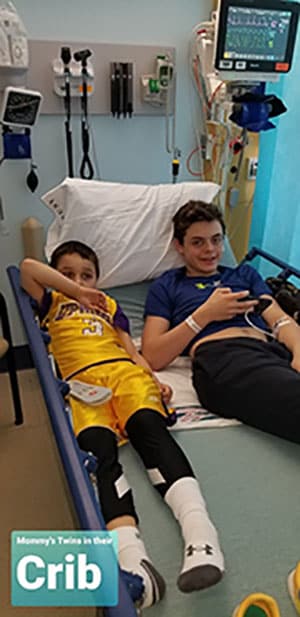Real Stories from People Living with Hemophilia – Mikey
Mikey’s Story

My name is Michael “Mikey” Daniel White, Jr. I am 14 years old and in the 9th grade. I was diagnosed with hemophilia B (factor lX deficiency) at age 3. Prior to my hemophilia diagnosis, I experienced a lot of bleeding, particularly when I was circumcised as a newborn. Following the circumcision, I was hospitalized and required surgery and treatment with a blood clotting factor product. Over the years, I’ve also struggled with falling often, resulting in many bruises and even surgery to remove a hematoma (blood that collects or “pools” outside the blood vessel).
Since my hemophilia diagnosis is part of who I am, affecting my lifestyle choices, I wanted to share my story of being an athlete with hemophilia B. I hope it encourages other people with bleeding disorders to pursue athletics and inspires others to accept and appreciate their bodies as they are. Thank you to the Centers for Disease Control and Prevention (CDC) for allowing me this opportunity.
When I was younger, I played basketball and baseball before finding my true passion: competitive swimming. Since I’m tall, I played the center position on my basketball teams, which often resulted in hematomas, nosebleeds, knee injuries, and other injuries requiring supportive care. Playing baseball also had its challenges. I’m left-handed, so I got hit by a lot of pitches during Little League. One of these hits caused a chest bleed that left the imprint of the ball’s stitching on my skin and many bruises on the right side of my body. I also sustained many “black eyes” while playing both of these sports. In the fall of 2018, one of my good friends suggested I try a swimming camp at the local YMCA. While I missed the physical contact of basketball and participating in such a popular sport, swimming is without a doubt my sport. Competitive swimming is a noncontact sport, so it complements my hemophilia, while still being an intense and rigorous sport. I love the competitive nature of swimming, both on a school and private team, and as an individual USA swimmer.
Being an athlete with hemophilia is uniquely challenging. It is also rewarding because the steps needed to get to that level of athleticism requires dedication, courage, body awareness, and speaking up for myself. Because of my hemophilia, I have had to miss practices, make up this missed practice time in the pool, worry about injuries, ice injuries, make accommodations for my pain (such as kicking all practice if I have an arm injury or bleed), and have infusions of replacement factor for bleeds.
In the Fall of 2020, I started to self-infuse (take an injectable medicine) every 2 weeks to help prevent and control my bleeding. I was able to do so with the guidance and support of my healthcare team. I am proud of my commitment to my swimming goals and understand that rigorous training can lead to microbleeds (small amounts of internal bleeding that can occur without symptoms). For this reason, I decided to start preventive treatment to be able to train at the level needed to meet my goal of being a successful, self-motivated swimmer. I hope that by reaching my goal, I can encourage others with chronic diseases and disorders to try different sports that pair well with their individual attributes.

Being an athlete with hemophilia requires support. Having an understanding coaching staff familiar with my unique medical needs makes me more confident and willing to push myself. My coach has made me the swimmer I am today. He motivates me to be the best swimmer I can be by helping me:
- Work on proper stroke technique to prevent future muscle injuries and joint problems;
- Weight train so my muscles become stronger and less likely to become injured; and
- Perform plyometric exercises (powerful aerobic exercises to increase your speed, endurance, and strength) and dry land workouts via Zoom.
My family and friends and swim teams are also very encouraging of my goals to be a competitive swimmer despite my hemophilia. With support from my coaches and team members, in addition to my dedication and determination, I am happy to say that I was able to beat three swim team records in 8th grade (50yard Freestyle, 100 yard Freestyle, and 200 yard Freestyle).
The COVID-19 pandemic has challenged my competitive swimming training, with pools closing or having reduced capacity. I overcame this hurdle by increasing strength training using a pulley weight training system at home, dry land Zoom workouts with my coach and team, and tethered swim workouts in the summer, as well as being flexible with available local pool time, jumping rope, and finding other activities that complement training to improve my swimming out of the water. COVID-19 has made me more committed as a swimmer by helping me realize my potential and my passion for swimming.
I hope that by sharing my story with CDC, it increases hemophilia awareness, helps others with bleeding disorders or chronic conditions realize their full potential, and encourages others to accept their bodies, as everyone is created uniquely. I especially want to inspire my younger brother who has hemophilia just like me. Being a competitive swimmer has taught me that you can be a great athlete with hemophilia; it doesn’t have to be a limitation.
Mikey wishes to recognize and thank the following people for their support:
- Andrea Dvorak, MD
- Thyda Teng, RN
- Swim Coaches Gennaro D’Agostino, Melanie Bruce, and Jim Funiciello
